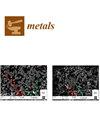提高激光熔覆高熵合金涂层的高温耐磨性:综述
IF 2.5
3区 材料科学
Q3 MATERIALS SCIENCE, MULTIDISCIPLINARY
引用次数: 0
摘要
作为近年来出现的一种新型金属材料,高熵合金具有简化的微观结构、高强度、高硬度和耐磨性等特性。高熵合金可以利用激光熔覆技术生产出与基体具有良好冶金结合的涂层,从而显著提高材料表面的耐磨性。本文主要基于一些添加合金元素和硬质陶瓷相的影响,分析了提高高熵合金涂层(LC-HEACs)高温耐磨性的研究进展。在此基础上,本研究主要探讨了添加铝、钛、铜、硅和钼等元素以及 TiC、WC 和 NbC 等硬陶瓷颗粒对涂层相结构、高温机理以及这些元素之间协同作用的影响。此外,本文还探讨了有前景的润滑颗粒的潜力,并介绍了一种创新、高效的增材制造技术,即极速激光金属沉积(EHLMD)。最后,本文总结了提高 LC-HEAC 高温耐磨性的主要困难以及未来发展中值得关注的一些问题。本文章由计算机程序翻译,如有差异,请以英文原文为准。
Improvement of High Temperature Wear Resistance of Laser-Cladding High-Entropy Alloy Coatings: A Review
As a novel type of metal material emerging in recent years, high-entropy alloy boasts properties such as a simplified microstructure, high strength, high hardness and wear resistance. High-entropy alloys can use laser cladding to produce coatings that exhibit excellent metallurgical bonding with the substrate, thereby significantly improvement of the wear resistance of the material surface. In this paper, the research progress on improving the high-temperature wear resistance of high entropy alloy coatings (LC-HEACs) was mainly analyzed based on the effect of some added alloying elements and the presence of hard ceramic phases. Building on this foundation, the study primarily examines the impact of adding elements such as aluminum, titanium, copper, silicon, and molybdenum, along with hard ceramic particles like TiC, WC, and NbC, on the phase structure of coatings, high-temperature mechanisms, and the synergistic interactions between these elements. Additionally, it explores the potential of promising lubricating particles and introduces an innovative, highly efficient additive manufacturing technology known as extreme high-speed laser metal deposition (EHLMD). Finally, this paper summarizes the main difficulties involved in increasing the high-temperature wear resistance of LC-HEACs and some problems worthy of attention in the future development.
求助全文
通过发布文献求助,成功后即可免费获取论文全文。
去求助
来源期刊

Metals
MATERIALS SCIENCE, MULTIDISCIPLINARY-METALLURGY & METALLURGICAL ENGINEERING
CiteScore
4.90
自引率
13.80%
发文量
1832
审稿时长
1.5 months
期刊介绍:
Metals (ISSN 2075-4701) is an open access journal of related scientific research and technology development. It publishes reviews, regular research papers (articles) and short communications. Our aim is to encourage scientists to publish their experimental and theoretical results in as much detail as possible. Therefore, there is no restriction on the length of the papers. The full experimental details must be provided so that the results can be reproduced. Metals provides a forum for publishing papers which advance the in-depth understanding of the relationship between the structure, the properties or the functions of all kinds of metals.
 求助内容:
求助内容: 应助结果提醒方式:
应助结果提醒方式:


